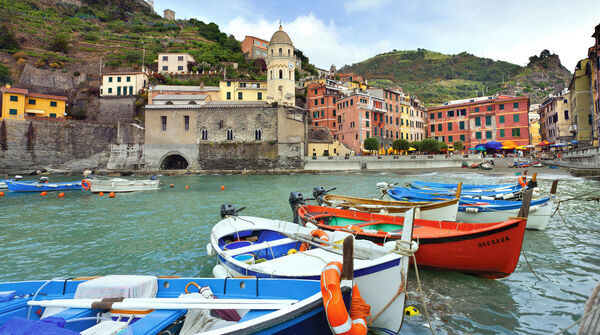Stepping Back in Vernazza
Among the five scenic seaside villages of Italy's Cinque Terre, Vernazza is my top pick for a home base.
By Rick StevesYou can search the entire Mediterranean coastline for the best rustic village, surrounded by vineyards and steeped in tradition, and not find a more rewarding escape than tiny Vernazza, my favorite of the five villages that make up Italy's Cinque Terre.
The Cinque Terre is a quintet of villages clinging to a bit of rugged coastline between Genoa and Pisa. Long cut off from the modern world, this remote stretch of the Italian Riviera only became easily accessible with the coming of the train.
Of the Cinque Terre's five towns, Vernazza, overseen by a ruined castle and an old church, is my personal top pick. The occasional train popping in and out of the mountain tunnels is the only reminder that the modern world is still out there somewhere. It's a tough community long living off the sea — and, in the last generation, living off travelers who love the sea. The church bells dictate a relaxed tempo. Yellow webs of fishing nets, tables bedecked with umbrellas, kids with plastic shovels, and a flotilla of gritty little boats tethered to buoys provide splashes of color. And accompanying the scene is the mesmerizing white noise of children at play, happy diners, and the washboard rhythm of the waves.
Vernazza's one street connects the harbor with the train station before melting into the vineyards. Like veins on a grape leaf, paths and stairways reach from the main street up into this watercolor huddle of houses that eventually dissolve into the vines high above. A rainbow of laundry flaps as if to keep the flies off the stout grandmothers who clog ancient doorways.
At the top end of town, Vernazza's scrawny access road hits a post, effectively a dead end for drivers. No cars enter this community of 600 people (except on Tuesday mornings, when a few vehicles show up for a tailgate-party street market, augmenting the skimpy business community). Like the breakwater that holds off waves at the bottom of town, the post holds back the modern storm at the top. But the town's castle no longer says, "Keep out." The breakwater is a broad, inviting sidewalk edged with boulders — reaching out into the sea like a finger beckoning the distant excursion boats.
The humble town gathers around its pebbled cove, where well-worn locals enjoy some shade on benches and tourists sunbathe on the rocks. In summer, the beach becomes a soccer ground, where teams comprised of local bar- and restaurant-workers provide late-night entertainment.
The cove is the closest thing to a natural harbor in the Cinque Terre. In the Middle Ages, the water went right up to the buildings, where boats would tie up, Venetian-style.
While Vernazza's fishing fleet is now down to just a couple of boats, locals are still more likely to own a boat than a car. Boats are tethered to buoys, except in winter or when the red storm flag indicates rough seas. In that case they're pulled up onto the little harborfront square, usually reserved for restaurant tables.
The town has two halves. Sciuiu (Vernazzan dialect for "flowery") is the sunny side on the left as you face inland, and Luvegu ("dank") is the shady side on the right. But from end to end, everything's painted in one of the "Ligurian pastels," as regulated by a commissioner of good taste in the regional government. Up on the far right, a castle — now just a tower, some broken stone walls, and a grassy park — served as the town's lookout back in pirate days. Below the castle, an interior arcade connected houses — ideal for fleeing attacks.
Village churches are always worth popping into. Vernazza's, on the harborfront, is unusual for its east-facing entryway, rather than the more typical western orientation. Hanging on the wall inside are three historic portable crosses — replicas of crosses that (locals like to believe) Vernazzan ships once brought along on crusades to the Holy Land. During religious processions, these crosses are taken down and carried through town.
In front of the church, a mini piazza decorated with a river-rock mosaic is a popular hangout. It's where the town's old ladies soak up the day's last bit of sun and kids enjoy a rare patch of level ball field.
Evenings in Vernazza are well-spent sitting on a bench and people-watching, either with a gelato or a glass of local white wine (borrow the glass from a bar; they don't mind). During the passeggiata (evening stroll), locals meander lazily up and down the main street — why not join them? Or look up to gaze back at the people looking out the windows of their faded pastel buildings, like a gallery of portraits hanging on ancient walls. Here in Vernazza it seems most members of the generation that grew up without screens spend time posted at their windows, watching over a world as timeless and reassuring as the Mediterranean tide.


